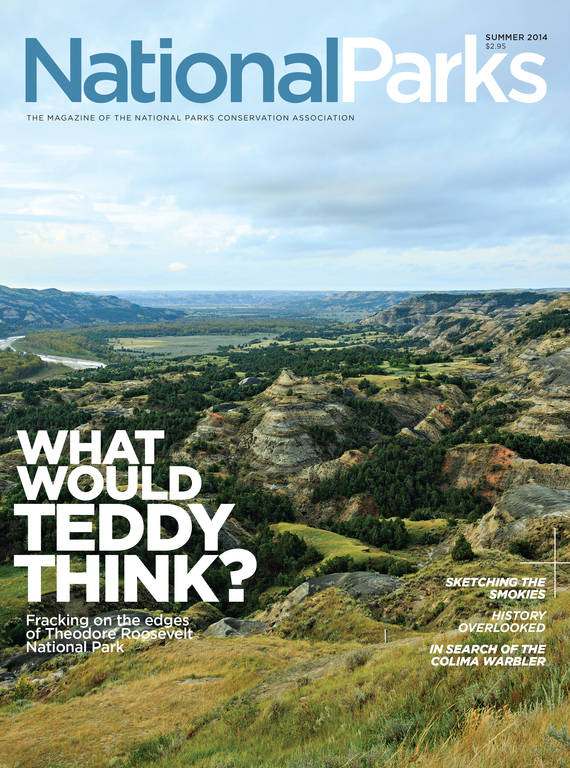Summer 2014
A Wing and a Prayer
Want to spot a Colima warbler in the United States? Head to Big Bend National Park—and cross your fingers.
In the morning, put on some sunscreen and haul yourself up the rocky switchbacks of the Pinnacles Trail (“Difficulty: Strenuous”) to its junction with the Emory Peak Trail. There, over the sound of your own panting, listen for a particular bird call: a fast-paced, high-pitched staccato trill that sounds like a rusty bicycle putting on the brakes. If you can follow the call through the dry oaks to its source—a small brownish bird with a yellow rump and white eye ring—you’ve found the Colima warbler, and for that moment you’re the King of American Birders. No native bird in the continental United States is quite as difficult to find.
Political boundaries don’t always line up with environmental ones, and birders pay lots of attention to places where a certain habitat—and its unique birds—exists on only a small piece of U.S. soil. Among these popular birding destinations are the tropical hardwood forests of far southern Florida, the Chiracahua Mountains of southern Arizona, and the western Alaskan tundra. The Chisos Mountains in Big Bend National Park also fall into this category, and because these peaks are the only place to find the Colima warbler in the United States, a visit to the park is on every devoted birder’s bucket list.
My number came up this spring, when I lucked into a gig as staff representative on an NPCA ParkScapes trip to Big Bend. I leapt at the opportunity to visit a national park I’d never seen and the chance to see the legendary Colima warbler. With the excitement came nervousness: The trip was scheduled for the second week of April, about a week or two before Colima warblers are seen with regularity in the park. Would I fly, drive, and hike all that way and not find my tiny target? I crossed my fingers and headed to Texas.
BREAKING RECORDS
Ornithologically speaking, the Colima warbler isn’t anything to write home about. It’s a member of a large family of migratory, insect-eating songbirds called Parulidae, or wood-warblers. Some species in the Parulidae family are among the brightest and most colorful birds found in the United States, such as the glowing yellow prothonotary warbler or the flashy, black-and-orange American redstart. The Colima warbler, though, is less inspiring. It’s a drab combination of brownish-gray and yellow, quite similar to but less colorful than its closely related and more widespread Parulidae cousins, Lucy’s and Nashville warblers. The Colima warbler is common in high-elevation oak and pine forests of the Sierra Madre Oriental mountain range in eastern Mexico, but just one of those forests exists in the United States.
Despite the Colima warbler’s unspectacular appearance, its unusually limited range is enough to support a small but stable economy catering to birders on a mission to see every American species. According to David Elkowitz, chief of interpretation at Big Bend, hundreds if not thousands of birders visit the park each spring and summer looking primarily for the Colima warbler. Every major birding tour company has a spring trip to Big Bend. Peggy Watson of Field Guides has been leading tours to Big Bend for 27 years and has only missed the Colima warbler once. Victor Emmanuel first saw a Colima warbler in Big Bend in 1959 and has been leading tours of the park with his own company since the mid-1970s.
Most daunting to birders looking for the Colima is the infamous hike up the Pinnacles Trail to the bird’s preferred habitat. “It’s a real physical test,” says Jeff Gordon, president of the American Birding Association. “For flatlanders unused to the altitude, the switchbacks can be a significant challenge.” Watson was less subtle: “It’s like climbing stairs for two miles.”

National Parks
You can read this and other stories about history, nature, culture, art, conservation, travel, science and more in National Parks magazine. Your tax-deductible membership donation of $25 or more entitles…
See more ›For the guides, the physical exertion is paired with the anxiety of making sure participants—most of whom signed up just for the Colima warbler—get the bird they’re after. The use of playback recordings to lure birds is forbidden in the National Park System (it’s considered harassment of the species), so guides rely on their eyes and ears. “The first sensation for a group seeing the Colima is relief,” says Watson, “and it’s always the bird they toast at dinner that night.”
Hoping to raise a glass myself, I hustled up the Pinnacles Trail on the fourth day of my trip. The steepness of the hike didn’t bother me so much, mostly because I was busy worrying about the fact that park staff below said no Colima warblers had been reported yet that spring. The other eager birders and I worked our way into appropriate Colima habitat and looked and listened. Nothing. We reached the summit of the Pinnacles Trail and scoured the woods with our binoculars for a couple of miles down the Boot Canyon Trail. No bird. Dismayed, we returned to eat lunch with the rest of the group at the top of Pinnacles. I thought the plan was to turn around and head back down, but our guide suggested the group check out the Boot Canyon Trail. “We birded that already,” I thought to myself, “but why not?” About a half-mile later, we were sorting through a mixed flock of birds when a small, grayish-brown bird popped into view. Its back was to me, and I could see yellow on its rump, and when it turned its head its white eye ring was clearly visible. The Colima warbler! We shouted. We clapped. We hugged and high-fived. I took a deep breath of cool mountain air and savored my brief reign as the King of American Birding. The walk back down was a breeze.
About the author
-
 Nicholas Lund Former Senior Manager, Landscape Conservation Program
Nicholas Lund Former Senior Manager, Landscape Conservation ProgramNick is a nature writer whose writing on birds and nature has appeared in Audubon magazine, Slate.com, The Washington Post and more. His most recent book is "Dinosaurs to Chickens: How Evolution Works." He lives in Maine with his wife and son and works for Maine Audubon.



